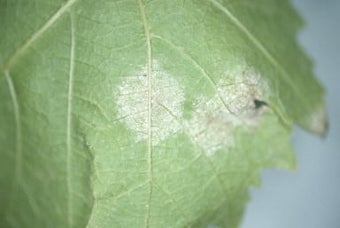
Quick facts
Common name - Aquilegia downy mildew
Scientific name - Peronosporaaquilegiicola
Plants affected - Aquilegia
Main symptoms - Yellow leaves, leaf and flower loss, white 'fungal' growth
Caused by - Fungus-like (Oomycete) organism
Timing - Spring and Autumn
What it is
Aquilegia downy mildew is a disease caused by Peronospora aquilegiicola, which is a fungus-like organism. Being closely related to algae, downy mildews thrive in cool, damp conditions. Downy mildews can spread from plant to plant by airborne or rain-splashed spores and may be seed-borne, but bought seed is likely to be disease-free.
Outbreaks of Aquilegia downy mildew in UK gardens began to be reported to RHS Gardening Advice in 2013, and in 2016 Defra decided that no statutory action would be taken against the disease.
Symptoms
You may see the following symptoms:
- On leaves: Affected leaves develop angular, yellow or purple patches that enlarge, and eventually the whole leaf curls and turns brown. A fine whitish/purple 'fungal' growth may be visible on the lower leaf surface
- On flowers: Flowers become distorted and look water-soaked. Flower stalks develop purple blotches. If infection occurs after flowering, the seed pods can develop brown patches and fail to produce seed
- Whole plant: Sometimes the whole plant can suffer from a deep-seated infection, known as a systemic infection. Plants affected in this way are usually stunted, with pale, often curled leaves, and large amounts of 'fungal' growth.
Images to aid diagnosis can be found on the National Aquilegia Collection Holder's website.

Control
Non-chemical control
Hygiene measures can greatly reduce the risk of resting spores contaminating soil, from where they can infect subsequent plantings of Aquilegia. Affected plants should be disposed of as soon as possible. Do not them. Ideally burn them or bury them deeper than 50cm (20in). Although the spores should not survive the commercial used for council collections, it is best to deal with contaminated material within the garden.
Because of the risk of soil contamination, rest affected areas from Aquilegia for at least a year (some species of Peronospora affecting other plants produce resting spores that can survive for several years but this information is unclear for Aquilegia downy mildew).
Where infected plants have been grown in containers, replace the compost (bury contaminated compost, ideally in a vegetable plot) and wash using a garden disinfectant, as directed by the manufacturer, to cleanse the container if you intend to grow Aquilegia in it again the following year.
It is not yet known if Aquilegia downy mildew can be seed-borne. The full host range of the disease is not yet known, but downy mildews usually only affect a limited range of plant species.
Seek assurances from suppliers that plants offered are disease-free. Growing from seed is a lower risk source of plants than buying plants from sources that are unable to offer suitable assurances.
No resistant cultivars (varieties) of Aquilegia are currently available. It is known that the disease can also affect the related plant Semiaquilegia, although it has not yet been found on this plant in the UK. However, where the disease has been found on Semiaquilegia (for example, in Asia), plants affected by the disease were visually almost indistinguishable from healthy plants, so perhaps they could be considered for use in areas affected by the disease, where it may prove difficult to grow Aquilegia successfully.
Do not use excessive amounts of nitrogen rich fertiliser, which can lead to soft, susceptible growth. Avoid crowded plantings where air movement is limited.
Chemical control
There are no fungicides available to gardeners for the control of this disease.
Biology
Downy mildews are a large group of plant diseases caused by microscopic fungus-like organisms related to the pathogen that causes potato blight.
Despite a similar name and certain similarities in symptoms, they are unrelated to the powdery mildews, which also affect aquilegia.
The disease is spread by spores produced on the underside of infected leaves. These spores are splashed by rain, and are also carried for long distances on the wind. Extended periods of leaf wetness are required for spore production and infection, so severe outbreaks of downy mildew are only likely to occur during wet springs and summers.
The airborne spores remain viable for just a short time, but it is thought that the fungus can also produce a second spore type (a resting spore) within the affected plant tissues. Resting spores are much more resilient, and are released into the soil as the diseased material rots down. These resting spores could survive within the soil for several months to several years.





